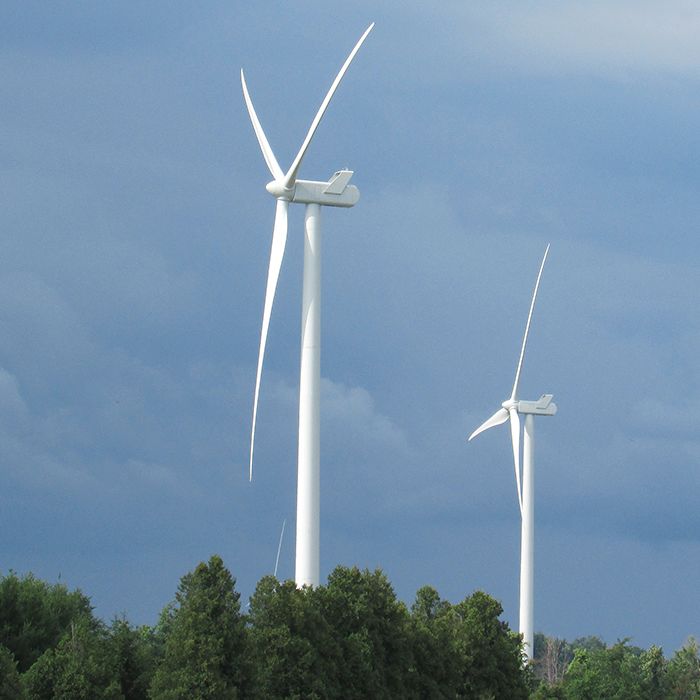
A posting on the Ontario Environmental Registry regarding the Romney Wind Energy Centre turbine project has opponents of pile-driving construction methods for turbine foundations claiming victory.
Essex NDP MPP Taras Natyshak, who has been outspoken on the well water issue in north Chatham-Kent, called on the Wynne Liberals to finally acknowledge that pile-driving poses a risk to local groundwater after reading the conditions of the Romney project’s Renewable Energy Approval (REA) permit which included that the company “not utilize pile foundations for project infrastructure” during construction.
Company officials, however, said in a statement that the Romney Wind Energy Centre did not apply for nor plan to use pile foundations as part of the wind turbine design of the project.
Romney Wind Energy Centre is a 60 MW wind project located in Chatham-Kent and the Town of Lakeshore with 17 wind turbines planned to be operational by the end of 2019. The project is co-owned by EDF Renewables and Aamjiwnaang First Nation.
Fabiola Oribe, lead advisor, community engagement for EDF Renewables, said Romney Wind Energy Centre conducted extensive geotechnical work at each proposed wind turbine location to better understand the subsoil conditions of the project area prior to final project open houses and the REA submission to Ministry of Environment and Climate Change (MOECC).
“The results of the geotechnical work were clear that Romney Wind would not require pile foundations. Our engineers determined that a foundation design consisting of a solid concrete gravity base – a common foundation used to build similar wind projects – is most appropriate for Romney Wind,” Oribe said in an e-mail statement from EDF. “The intention to build Romney Wind using a solid, gravity based concrete foundation was communicated in our public meetings held in Chatham-Kent and Lakeshore in May 2017 and presented to MOECC in our REA documents. After a thorough review, MOECC issued Romney Wind REA on March 16, 2018 and then posted the REA to the Environmental Registry.”
The fact, however, that MOECC staff put the no-pile driving condition in the permit, is seen by Natyshak, members of Water Wells First and Chatham-Kent Essex MPP Rick Nicholls as an acknowledgement of the harmful effects on the underground aquifer of pile driving.
“Ministry staff have confirmed what farmers and residents in Chatham-Kent have known ever since their well water turned black. Pile-driving construction puts the groundwater at risk. So, ministry staff have acknowledged that pile driving is a risk to the groundwater in Chatham-Kent. Why hasn’t the Premier?” Natyshak asked.
“I see this as a little bit of progress,” he said. “I’m optimistic they (government) are asking for future projects, at least in this area, that pile driving not be used during construction.”
Natyshak added a blog posting earlier this year by a Hydro One contractor responsible for building the hydro towers that connect to the North Kent wind site, stated it eliminated the use of pile-driving from their own project because of the “possible risk to nearby wells.” Shortly after the issue was raised in the Legislature last month, the statement disappeared from the company’s website.
“For months, farmers and residents in the Chatham area have complained about black well water, which started appearing after Samsung began pile-driving construction for its North Kent wind turbine site,” Natyshak said. “The premier won’t listen to these families, she refuses to admit there is a problem.”
Nicholls said it appears the permit condition to not use pile driving “is an admission of guilt” from the government that pile driving is affecting area water wells that have been clogged with sediment.
And what he sees as equally important for residents is the ability to complain if they are experiencing water well, noise or vibration issues with a wind project, and he has introduced legislation to that effect with full caucus support.
Nicholls said he understands the importance of alternative forms of energy, but said he has his doubts about wind energy, which makes the well contamination particularly upsetting.
“Ordinarily, citizens would go public, and complain loudly. But not in this case. Wind farm companies have put non-disclosure agreements into their contracts. They do this in order to prevent residents from talking about health hazards and pollution connected with building wind farms. I think this is wrong,” Nicholls said recently in an opinion piece. “In order to solve this problem, and restore accountability, I’ve brought forward a Private Member’s Bill (PMB). My bill will make it impossible to put non-disclosure agreements into windfarm contracts.”
Nicholls said he won’t stop there and will keep pushing for a thorough investigation into the North Kent wind farm.






